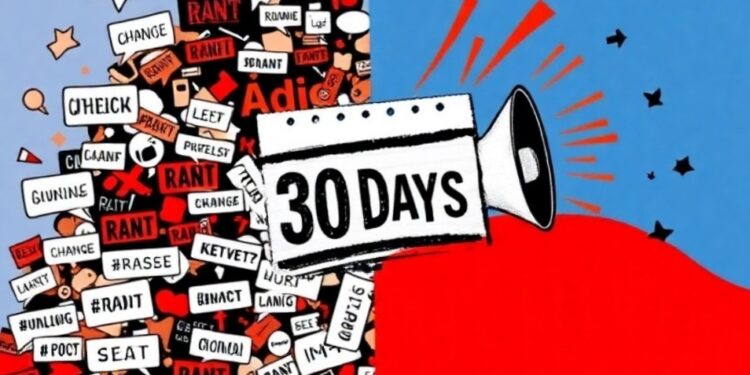Participants commit to 30 consecutive days of airing grievances—often about politics, societal inequities, or corporate overreach—via posts, videos, or threads. What began as a grassroots outlet for frustration has sparked a debate among stakeholders: Is this a meaningful release of collective angst, or just another layer of digital noise?
The Pulse of the Challenge
A quick dive into X reveals a polarized reception. Some users champion the challenge as a pressure valve, a way to vocalize discontent in a world where traditional avenues—like town halls or op-eds—feel increasingly out of reach. “Finally, a space to say what’s really on my mind without filters,” one participant posted, echoing a sentiment of empowerment. Others, however, see it as a futile gesture. “30 days of ranting won’t move the needle when the people in charge don’t even log on,” another user quipped, highlighting a skepticism rooted in pragmatism.
This divide reflects a broader tension in digital engagement: the line between expression and efficacy. For stakeholders—whether businesses, policymakers, or community leaders—the challenge raises questions about how online movements influence real-world outcomes, and whether they’re worth the attention.
A Mirror to Society
The #30daysrantchallenge isn’t just a random hashtag; it’s a symptom of a frustrated zeitgeist. In an era of economic uncertainty, political polarization, and climate anxiety, people are turning to platforms like X to vent. The challenge’s structure—30 days of sustained critique—offers a marathon-like catharsis that shorter-lived trends can’t match. It’s less about the viral stunts of yesteryear (think Ice Bucket Challenge) and more about endurance, a digital endurance test for an exasperated public.
For businesses, this presents both risk and opportunity. On one hand, brands risk being caught in the crosshairs of rants—whether about pricing, ethics, or labor practices. On the other, it’s a chance to listen. Stakeholders who monitor these conversations can glean unfiltered insights into customer pain points, employee morale, or public perception—data that surveys might miss. Ignoring it, however, could mean missing a shift in sentiment until it’s too late.
The Efficacy Question
But does it matter? History suggests online outrage rarely translates to systemic change without offline action. The Arab Spring leveraged social media to topple regimes, but it was boots on the ground that sealed the deal. Closer to home, movements like #MeToo gained traction through X but owed their impact to legal battles and cultural shifts beyond the screen. The #30daysrantchallenge, by contrast, lacks a clear call to action—making it more scream than strategy.
Critics argue it’s a distraction, a way to feel proactive without being productive. Supporters counter that awareness is the first step, a spark that could ignite something bigger. The truth likely lies in between: a rant can amplify a cause, but only if it’s paired with intent.
What Stakeholders Should Do
For those with a stake in this digital ecosystem—corporations, NGOs, or governments—the challenge isn’t just a trend to watch; it’s a signal to decode. Here’s how to engage:
Listen Actively: Use tools to analyze #30daysrantchallenge posts. What themes emerge? Are they about your sector? Your brand? This is raw, real-time feedback.
Respond, Don’t React: If the rants target your organization, resist the knee-jerk defense. Acknowledge the frustration, then act—whether through policy tweaks or transparent dialogue.
Channel the Energy: Encourage participants to move beyond rants into solutions. Partner with influencers or host forums to turn gripes into actionable ideas.






































